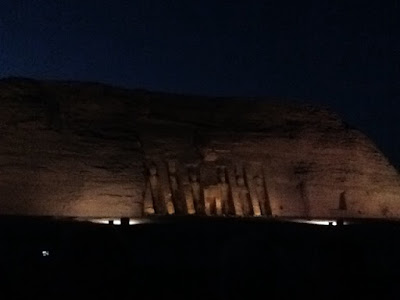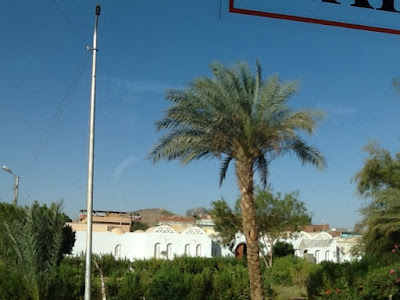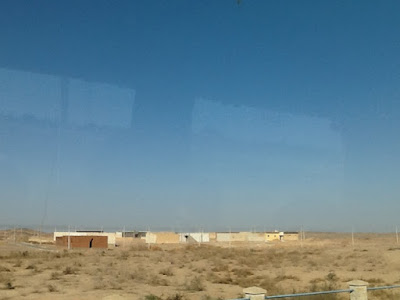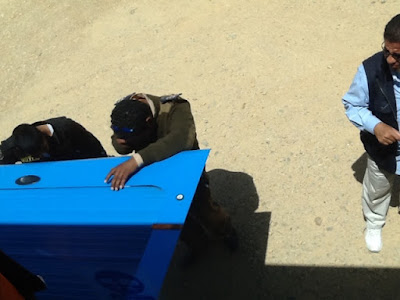/Photo by Patricia Leslie
Who doesn't want to go to Egypt? Land of ancient mysteries, pyramids, the afterlife, kings and queens, the Nile, a rich past.
You don't have to go all the way to Egypt to catch a glimpse of its history and learn about its women rulers who governed the country for hundreds of years. Many of their remnants have come to us in Washington, courtesy of the National Geographic Museum, Egypt, and world-renowned museums which have loaned 300 objects for a stellar presentation, Queens of Egypt.
"Ramses the Great" (Ramses II), the builder of Abu Simbel whom the label calls "perhaps the most famous ruler of ancient Egypt," is seated here between two patron deities of Thebes, the god Amun on the left and the goddess Mut. All the figures (men and women, gods and mortals) are the same size symbolizing their equality. Ramses's stature enabled him to connect the mortals with the gods "preserving cosmic balance." Granite, Temple of Amun, Karnak, c. 1279-1213 BC, Museo Egizio, Turin, Italy/Photo by Patricia Leslie
Researchers believe this fragment likely came from one of the standing colossi at Amenhotep III's temple in Thebes where a series of huge statues stood in the court. More large statues were built during Amenhotep III's reign than during any other pharaoh's rule. Granite, c. 1390-1353 BC, Museo Egizio, Turin, Italy/Photo by Patricia Leslie
Mut, whose name means "mother," was revered in Egyptian society, according to the label, because "she was a supportive and dutiful wife, a powerful queen, and an honored goddess," in other words, "a role model." She and her spouse, the god, Amun-Ra, were king and queen of the gods in the New Kingdom. Limestone, c. 1292-1250 BC, unknown provenance, Museo Egizio, Turin, Italy/Photo by Patricia Leslie
A youg boy called Amenmes is identified by his lack of clothing and his "traditional side-lock." His skin is redder than women's because of men's roles outside the home. Unknown provenance, c. 1500-1450 BC/Photo by Patricia Leslie
A rare likeness of Isetnofret, the second Great Royal Wife of Pharaoh Ramses II, who son, Merenptah, became pharaoh. Her name is inscribed on the statue's right shoulder. Two protective cobras adorn her forehead ("a double uraeus."). Sandstone, c. 1279-1213 BC, Royal Museums of Art and History, Brussels/Photo by Patricia Leslie
At the exhibition/Photo by Patricia Leslie
Ernesto Schiaparelli found fragments of Queen Nefertari's sarcophagus in her burial chamber in 1904, but the tomb was empty, stripped by grave robbers. No Egyptian queen's tomb has ever been found intact/Photo by Patricia Leslie
Model of Nefertari's Tomb. Built shortly after 1904 when Mr. Schiaparelli discovered Nefertari's tomb in Egypt's Valley of the Queens. Drawn on a 1/10 scale, the paintings from her tomb walls were carefully copied and reproduced. Wood, made by Francesco Ballerini, Edoardo Baglione, and Michelangelo Pizzio, early 20th century, Museo Egizio, Turin, Italy/Photo by Patricia Leslie
Although Mr. Schiaparelli found Queen Nefertari's tomb empty, he did find fragments of the pink granite stone sarcophagus and her wooden tomb in her burial chamber, all destroyed by grave robbers. Also, he discovered a box lid (in bottom left corner, above) belonging to the queen which likely housed the shabtis (on the right in the picture. See more shabtis below.)./Photo by Patricia Leslie
#4 This limestone fragment (called an ostracon) depicts Sethherkhepeshef (with his hands raised in worship), one of Pharaoh Ramses III's sons. The fan in his left hand indicates high status. The sketch may be intended as decoration for his tomb. Limestone and red paint, Valley of the Queens, c. 1186-1155 BC,
Museo Egizio, Turin, Italy/Photo by Patricia Leslie
A carved relief of Pharaoh Ramses III, the last great pharaoh of the New Kingdom. During his long reign, invaders often attacked Egypt which depleted the treasury, leading to Egypt's gradual decline. The first recorded labor strike occurred in the 29th year of his reign. Here he offers wine to a seated goddess, and his mother, Queen Tiy-Merenese follows him. Although his mother may have lived in the harem at times (little evidence of harem life is found anywhere), she more likely resided in her own palace, according to the label copy. Limestone, c. 1185-1155 BC, Royal Museums of Art and History, Brussels/Photo by Patricia Leslie
Around 1155 BC, Ramses III was murdered by one of his wives, Queen Tiy, working with a gang of 38, but the crime failed to install her desired heir. A transcript of the court proceedings of the conspirators' trial is recorded on this papyrus scroll. They suffered their deed harshly/Photo by Patricia Leslie
This is the goddess Sekhmet with the body of a woman and the head of a lion whose cobra head symbolizes her power. Her craving for blood and her wish to end mankind drove the gods to trick her into drinking red beer which turned her into a gentle cat goddess, Bastet. (Cats are gentle?) Rituals were held every year to make sure Sekhmet/Bastet remained "gentle." Granodiorite, c. 1390-1353 BC, Museo Egizio, Turin, Italy/Photo by Patricia Leslie
For formal occasions, hair styles among elite women of the 18th dynasty (1353-1336 BC) often included wearing human hair wigs on shaven heads. The less well-off had to wear itchy "date-palm fiber" wigs. The label notes that wigs changed fashion faster than clothing or jewelry. The limestone female in #1 above wears a Nubian-styled wig and a disc earring. Museo Egizio, Turin, Italy/Photo by Patricia Leslie
A bronze hairpin is #2. from c. 1539-1075 BC, Museo Egizio, Turin, Italy. A closeup of #3 is below.
Combs were often decorated with animal motifs like this member of the cat family. Wood, c. 1539-1292 BC, Royal Museums of Art and History, Brussels/Photo by Patricia Leslie
Worker shabtis, placed in tombs, were intended to look like the deceased. The shabtis were responsible for manual labor for the dead in afterlife. See Queen Nefertari's shabtis above. Wood or limestone, c. 1292-1075 BC, Museo Egizio, Turin, Italy/Photo by Patricia Leslie
The coffin of Ruru which was later used by a man. Wood and paint from the Valley of the Queens, Museo Egizio, Turin, Italy/Photo by Patricia Leslie
The coffin of Asetemhat is plush with symbols of several gods: Nut, goddess of the sky; Osiris, god of the underworld; and Anubis, god of the dead, who mummifies Asetemhat; Stuccoed wood and paint from the Valley of the Queens in Thebes, c. 722-525 BC, Museo Egizio, Turin, Italy/Photo by Patricia Leslie
These mummies close the show which has so captivated guests, the Queens' stay has been extended from September 2 to September 15, 2019. After that, Queen Nefertari and her belongings will depart for her next adventure at the Nelson-Atkins Museum of Art in Kansas City/Photo by Patricia Leslie
/Photo by Patricia Leslie
A free, color booklet of 24 pages is available.
What: Queens of Egypt
When: 10 a.m. - 6 p.m. daily through September 15, 2019. The last ticket is sold at 5 p.m.
Where: National Geographic, 1145 17th Street, NW, Washington, D.C. 20036
Tickets: Adults: $15; seniors, military, students: $12; children ages 5-12, $10; children under age 5 are admitted free. No charge for contributing members.
Closest Metro station: Farragut West or Farragut North
For more information: 202-857-7700
patricialesli@gmail.com
Who doesn't want to go to Egypt? Land of ancient mysteries, pyramids, the afterlife, kings and queens, the Nile, a rich past.
You don't have to go all the way to Egypt to catch a glimpse of its history and learn about its women rulers who governed the country for hundreds of years. Many of their remnants have come to us in Washington, courtesy of the National Geographic Museum, Egypt, and world-renowned museums which have loaned 300 objects for a stellar presentation, Queens of Egypt.
About 1400 years from the New Kingdom (16th through 11 centuries BC) though the last queen and pharaoh, Cleopatra VII (69-30 BCE) are covered. Sculptures, jewelry, a tomb model, a 3-D theatre, courtroom
documents and more tell the stories and unfold the dramas in 12,000 square feet at
the National Geographic Museum.
The show has so many compelling pieces it's hard to pick just one as favorite. Perhaps it's the reality that these women ruled thousands of years ago, and they didn't have to wait for laws and courtroom sagas and currents movements to give them rights and acceptance. They were way ahead in "the game."
Below are some of the Queens' pieces I found most intriguing and interesting, but there are too many to show here. Please visit and tell me what you think.
A statue of Idet and Ruiu which is unusual to find two women shown side by side since it's mostly couples sculpted when two figures are made together.The women's relationship is unknown although Idet seems the more important since she's seated on the right and is called the "lady of the house." Limestone, probably from the Theban Necropolis, c. 1480-1390 BC, Museo Egizio, Turin, Italy/Photo by Patricia LeslieThe show has so many compelling pieces it's hard to pick just one as favorite. Perhaps it's the reality that these women ruled thousands of years ago, and they didn't have to wait for laws and courtroom sagas and currents movements to give them rights and acceptance. They were way ahead in "the game."
Below are some of the Queens' pieces I found most intriguing and interesting, but there are too many to show here. Please visit and tell me what you think.
"Ramses the Great" (Ramses II), the builder of Abu Simbel whom the label calls "perhaps the most famous ruler of ancient Egypt," is seated here between two patron deities of Thebes, the god Amun on the left and the goddess Mut. All the figures (men and women, gods and mortals) are the same size symbolizing their equality. Ramses's stature enabled him to connect the mortals with the gods "preserving cosmic balance." Granite, Temple of Amun, Karnak, c. 1279-1213 BC, Museo Egizio, Turin, Italy/Photo by Patricia Leslie
Researchers believe this fragment likely came from one of the standing colossi at Amenhotep III's temple in Thebes where a series of huge statues stood in the court. More large statues were built during Amenhotep III's reign than during any other pharaoh's rule. Granite, c. 1390-1353 BC, Museo Egizio, Turin, Italy/Photo by Patricia Leslie
Mut, whose name means "mother," was revered in Egyptian society, according to the label, because "she was a supportive and dutiful wife, a powerful queen, and an honored goddess," in other words, "a role model." She and her spouse, the god, Amun-Ra, were king and queen of the gods in the New Kingdom. Limestone, c. 1292-1250 BC, unknown provenance, Museo Egizio, Turin, Italy/Photo by Patricia Leslie
A youg boy called Amenmes is identified by his lack of clothing and his "traditional side-lock." His skin is redder than women's because of men's roles outside the home. Unknown provenance, c. 1500-1450 BC/Photo by Patricia Leslie
A rare likeness of Isetnofret, the second Great Royal Wife of Pharaoh Ramses II, who son, Merenptah, became pharaoh. Her name is inscribed on the statue's right shoulder. Two protective cobras adorn her forehead ("a double uraeus."). Sandstone, c. 1279-1213 BC, Royal Museums of Art and History, Brussels/Photo by Patricia Leslie
At the exhibition/Photo by Patricia Leslie
Ernesto Schiaparelli found fragments of Queen Nefertari's sarcophagus in her burial chamber in 1904, but the tomb was empty, stripped by grave robbers. No Egyptian queen's tomb has ever been found intact/Photo by Patricia Leslie
Model of Nefertari's Tomb. Built shortly after 1904 when Mr. Schiaparelli discovered Nefertari's tomb in Egypt's Valley of the Queens. Drawn on a 1/10 scale, the paintings from her tomb walls were carefully copied and reproduced. Wood, made by Francesco Ballerini, Edoardo Baglione, and Michelangelo Pizzio, early 20th century, Museo Egizio, Turin, Italy/Photo by Patricia Leslie
Although Mr. Schiaparelli found Queen Nefertari's tomb empty, he did find fragments of the pink granite stone sarcophagus and her wooden tomb in her burial chamber, all destroyed by grave robbers. Also, he discovered a box lid (in bottom left corner, above) belonging to the queen which likely housed the shabtis (on the right in the picture. See more shabtis below.)./Photo by Patricia Leslie
#4 This limestone fragment (called an ostracon) depicts Sethherkhepeshef (with his hands raised in worship), one of Pharaoh Ramses III's sons. The fan in his left hand indicates high status. The sketch may be intended as decoration for his tomb. Limestone and red paint, Valley of the Queens, c. 1186-1155 BC,
Museo Egizio, Turin, Italy/Photo by Patricia Leslie
A carved relief of Pharaoh Ramses III, the last great pharaoh of the New Kingdom. During his long reign, invaders often attacked Egypt which depleted the treasury, leading to Egypt's gradual decline. The first recorded labor strike occurred in the 29th year of his reign. Here he offers wine to a seated goddess, and his mother, Queen Tiy-Merenese follows him. Although his mother may have lived in the harem at times (little evidence of harem life is found anywhere), she more likely resided in her own palace, according to the label copy. Limestone, c. 1185-1155 BC, Royal Museums of Art and History, Brussels/Photo by Patricia Leslie
Around 1155 BC, Ramses III was murdered by one of his wives, Queen Tiy, working with a gang of 38, but the crime failed to install her desired heir. A transcript of the court proceedings of the conspirators' trial is recorded on this papyrus scroll. They suffered their deed harshly/Photo by Patricia Leslie
This is the goddess Sekhmet with the body of a woman and the head of a lion whose cobra head symbolizes her power. Her craving for blood and her wish to end mankind drove the gods to trick her into drinking red beer which turned her into a gentle cat goddess, Bastet. (Cats are gentle?) Rituals were held every year to make sure Sekhmet/Bastet remained "gentle." Granodiorite, c. 1390-1353 BC, Museo Egizio, Turin, Italy/Photo by Patricia Leslie
For formal occasions, hair styles among elite women of the 18th dynasty (1353-1336 BC) often included wearing human hair wigs on shaven heads. The less well-off had to wear itchy "date-palm fiber" wigs. The label notes that wigs changed fashion faster than clothing or jewelry. The limestone female in #1 above wears a Nubian-styled wig and a disc earring. Museo Egizio, Turin, Italy/Photo by Patricia Leslie
A bronze hairpin is #2. from c. 1539-1075 BC, Museo Egizio, Turin, Italy. A closeup of #3 is below.
Combs were often decorated with animal motifs like this member of the cat family. Wood, c. 1539-1292 BC, Royal Museums of Art and History, Brussels/Photo by Patricia Leslie
Worker shabtis, placed in tombs, were intended to look like the deceased. The shabtis were responsible for manual labor for the dead in afterlife. See Queen Nefertari's shabtis above. Wood or limestone, c. 1292-1075 BC, Museo Egizio, Turin, Italy/Photo by Patricia Leslie
The coffin of Ruru which was later used by a man. Wood and paint from the Valley of the Queens, Museo Egizio, Turin, Italy/Photo by Patricia Leslie
The coffin of Asetemhat is plush with symbols of several gods: Nut, goddess of the sky; Osiris, god of the underworld; and Anubis, god of the dead, who mummifies Asetemhat; Stuccoed wood and paint from the Valley of the Queens in Thebes, c. 722-525 BC, Museo Egizio, Turin, Italy/Photo by Patricia Leslie
These mummies close the show which has so captivated guests, the Queens' stay has been extended from September 2 to September 15, 2019. After that, Queen Nefertari and her belongings will depart for her next adventure at the Nelson-Atkins Museum of Art in Kansas City/Photo by Patricia Leslie
/Photo by Patricia Leslie
A free, color booklet of 24 pages is available.
What: Queens of Egypt
When: 10 a.m. - 6 p.m. daily through September 15, 2019. The last ticket is sold at 5 p.m.
Where: National Geographic, 1145 17th Street, NW, Washington, D.C. 20036
Tickets: Adults: $15; seniors, military, students: $12; children ages 5-12, $10; children under age 5 are admitted free. No charge for contributing members.
Closest Metro station: Farragut West or Farragut North
For more information: 202-857-7700
patricialesli@gmail.com















